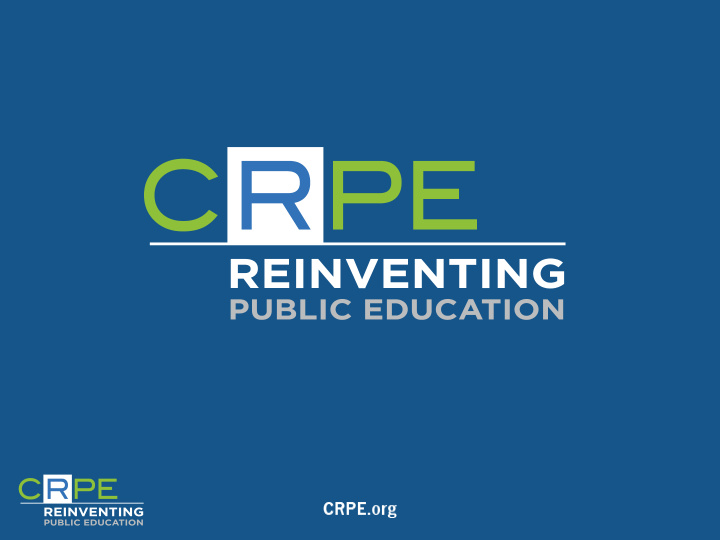



Solidifying Portfolio Through State and Local Policy Changes Kelly Hupfeld, Associate Dean, UC Denver Larry Miller, Sr. Research Fellow, CRPE 10 th Portfolio Conference Houston, TX January 28, 2014
Session Objectives • Identify real barriers to portfolio at the state and local level • Begin crafting a strategic plan to overcome barriers • Think tactically about how to successfully make policy changes
Target Audience • Districts that are stuck • Districts that are new to portfolio • Districts that have overcome a lot of implementation challenges • Districts that don’t have a state and/or local policy strategy • Districts who need a policy-process refresher
Session Agenda • Review state scorecards • Learn how peer districts changed state policy • Develop/refine state and local policy priorities • Provide feedback about this session
Barriers, Real & Imagined • Real barriers (one-third) – Often written, come with real consequences and offer no waivers/workarounds • Imagined barriers (two-thirds) – The way things have always been done • What should I do with all the c/o talent reform has attracted?
Ranking State Support for Portfolio • Policies that support portfolio’s 7 components • Secondary research • Rankings updated based on our knowledge • Just a starting point
Portfolio’s 7 Key Components Good Choices for All Families School Autonomy Pupil-Based Funding for All Schools Talent-Seeking Strategy Sources of Support for Schools* Performance-Based Accountability for Schools Extensive Public Engagement*
State Support & Local Progress State Local Local response Progress Support Advocate for state policy changes Advocate for state policy changes Ignore the state unless reforms threatened Implement, state adv. and local policy chg. Implement while advocating Ignore the state unless reforms threatened Implement, change local polices as needed Implement, change local polices as needed Ignore the state unless reforms threatened
Reflect on Your State’s Scorecard • Use local knowledge to re-rank components • List policies missing from the scorecard that support/limit portfolio? • Which state policies need to be changed? • Which state policies can you workaround?
Developing Your Strategy – 1 st Steps • Define your obstacle – is it real? • Define your goal – what do you need to be able to What do? • What are your options? • Who has authority to make the changes you need? Where • What is the process? • Who are the players? • What are your tactics? How
Example: Denver and ProComp • Obstacle: traditional salary schedule in CBA • Goal: differentiated pay What • Options: mandate through statute, force union, bargain with union Where • Legislature, bargaining table • Players: union, community activists, business • Tactics: Develop and pilot new system with union, take How referendum for “sweeten the pot” funding to voters
Example: The Cleveland Plan • Obstacle: State laws limiting autonomy, CBA provisions • Goals: Increased autonomy, ability to partner with charter schools to fully What implement Cleveland Plan • Options: legislation, CBA changes • State legislature, bargaining table Where • Players: mayor’s office, union, business and community leaders; prominent state-level politicians • Tactics: mayor-led process, union as partner, bipartisan support and ducks in a How row in advance, voter signaling of approval through funding election
Exercise: Crafting Your Strategic Plan • List your top three policy barriers – Identify source of each barrier • List what you could accomplish by removing each obstacle – Rank goals by importance • Verify: real or imagined?
Exercise 2: Tactics • From exercise 1, pick the real barrier with the greatest impact • What has to change about the policy? • What’s the policy change process? • Who are the policy’s stakeholders? • Can you win over your biggest opponent? How?
Closing Thoughts • Describe one way in which this session informed the way you think about implementing portfolio in your district • What are your next steps going to be when you get back to your district?
Parking lot
Thinking about Tactics More Sustainable Less Sustainable • Collaborative • Top down • Teacher and • Scorched earth community support • Viewed as ideological • Viewed as practical • No corresponding • Corresponding capacity capacity
Thinking about the Where Variable Red light Proceed with Full steam ahead caution Allies You have no allies OR You have the usual Your allies form a you have the wrong allies diverse and allies powerful coalition Opponents Everyone opposes you You have the usual No one who OR opponents matters opposes the only group that you matters opposes you Political Your plan would be DOA Support is Full bipartisan landscape in this environment fragmented or support plus the unpredictable governor Cost/benefit You can’t afford Cost and benefit You can afford lobbyists/this is not relatively equal lobbyists/essential essential to your to reforms reforms Community Your community Your community is Your community support actively opposes this lukewarm or just passed a huge effort disengaged tax increase supporting the
State Support: Good Choices • Intra and Inter district school choice • No caps on charter schools/charter enrollment • Support for innovation zones and schools • Support for 3 rd party providers
State Support: School Autonomy • State public employee collective bargaining law • Teachers in autonomous schools and charter schools are unregulated • Flexible funding (more general aid, less categorical aid)
State Support: Student- Based Funding • Student-based allocations are the dominant or only allocation mechanism • Availability and comparability of school-level financial data • Simplicity of financing formula • Progressive and equitable funding distribution
State Support: Talent • Support for 3 rd party providers and new schools (charters, innovation schools, availability of startup funds) • Availability of performance information • Performance-based teacher evaluation system, tenure, comp. and layoff system
State Support: Accountability • State makes performance information available, reliable, accessible • State authorized to close/intervene in failing schools
Recommend
More recommend